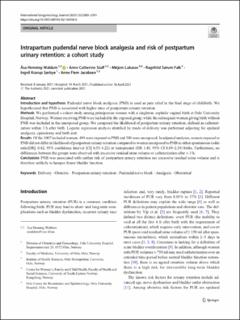| dc.contributor.author | Waldum, Åsa | |
| dc.contributor.author | Staff, Anne Cathrine | |
| dc.contributor.author | Lukasse, Mirjam | |
| dc.contributor.author | Falk, Ragnhild Sørum | |
| dc.contributor.author | Sørbye, Ingvil | |
| dc.contributor.author | Jacobsen, Anne Flem | |
| dc.date.accessioned | 2022-04-26T09:29:08Z | |
| dc.date.available | 2022-04-26T09:29:08Z | |
| dc.date.created | 2021-07-08T22:59:32Z | |
| dc.date.issued | 2021-04-16 | |
| dc.identifier.citation | International Urogynecology Journal. 2021, 32 2383-2391. | en_US |
| dc.identifier.issn | 0937-3462 | |
| dc.identifier.issn | 1433-3023 | |
| dc.identifier.uri | https://hdl.handle.net/11250/2992758 | |
| dc.description.abstract | Introduction and hypothesis: Pudendal nerve block analgesia (PNB) is used as pain relief in the final stage of childbirth. We hypothesized that PNB is associated with higher rates of postpartum urinary retention. Methods: We performed a cohort study among primiparous women with a singleton, cephalic vaginal birth at Oslo University Hospital, Norway. Women receiving PNB were included in the exposed group, while the subsequent woman giving birth without PNB was included in the unexposed group. We compared the likelihood of postpartum urinary retention, defined as catheterization within 3 h after birth. Logistic regression analysis stratified by mode of delivery was performed adjusting for epidural analgesia, episiotomy and birth unit. Results: Of the 1007 included women, 499 were exposed to PNB and 508 were unexposed. In adjusted analyses, women exposed to PNB did not differ in likelihood of postpartum urinary retention compared to women unexposed to PNB in either spontaneous (odds ratio[OR]: 0.82, 95% confidence interval [CI] 0.55–1.22) or instrumental (OR 1.45, 95% CI 0.89–2.39) births. Furthermore, no differences between the groups were observed with excessive residual urine volume or catheterization after > 3 h. Conclusions: PNB was associated with neither risk of postpartum urinary retention nor excessive residual urine volume and is therefore unlikely to hamper future bladder function. | en_US |
| dc.description.sponsorship | Open access funding provided by University of Oslo (incl Oslo University Hospital). This work was supported by a PhD grant from Oslo University Hospital, Norway. | en_US |
| dc.language.iso | eng | en_US |
| dc.publisher | Springer | en_US |
| dc.relation.ispartofseries | International Urogynecology Journal;32, (2021) | |
| dc.rights | Navngivelse 4.0 Internasjonal | * |
| dc.rights.uri | http://creativecommons.org/licenses/by/4.0/deed.no | * |
| dc.subject | Delivery | en_US |
| dc.subject | Obstetrics | en_US |
| dc.subject | Postpartum urinary retention | en_US |
| dc.subject | Pudendal nerve blocks | en_US |
| dc.subject | Analgesia | en_US |
| dc.subject | Obstetrical care | en_US |
| dc.title | Intrapartum pudendal nerve block analgesia and risk of postpartum urinary retention: a cohort study | en_US |
| dc.type | Peer reviewed | en_US |
| dc.type | Journal article | en_US |
| dc.description.version | publishedVersion | en_US |
| dc.rights.holder | © The Author(s) 2021 | en_US |
| cristin.ispublished | true | |
| cristin.fulltext | original | |
| cristin.qualitycode | 1 | |
| dc.identifier.doi | https://doi.org/10.1007/s00192-021-04768-0 | |
| dc.identifier.cristin | 1921083 | |
| dc.source.journal | International Urogynecology Journal | en_US |
| dc.source.volume | 32 | en_US |
| dc.source.issue | 32 | en_US |
| dc.source.pagenumber | 2383-2391 | en_US |

